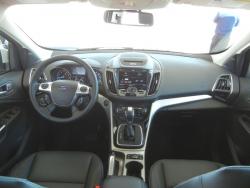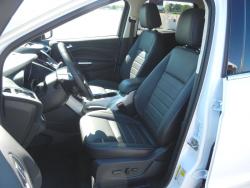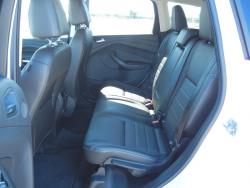Aside from feature content, the Ford interior is finished in top-notch materials that would be at home on a Lincoln or any other entry-level luxury vehicle. Interior quality is highlighted by contrast-stitched leather seats and high quality plastics of the soft touch variety on the dash and doors.
   2013 Ford Escape. Click image to enlarge |
While the centre stack design recalls a variety of alien robots (Cylons, Decepticons, take your pick), and the complexity of MyFord Touch may be a bit much for many of the owners surveyed in JD Powers (Ford suffered a significant drop in that company’s Initial Quality Survey because of interior ‘usability’ issues, as did many other brands), for those of us familiar with iPods and smartphones it shouldn’t be too much of a stretch to master. Ford is also working hard to calibrate screen sensitivity and system response times and reliability to improve the user experience on that front. The few minutes I tinkered around with this system was trouble free and simple to use—however, only a full Test Drive will give us enough time to really get familiar with that system and the recent improvements.
The Escape comes in a bit shy of most CR-V dimensions like cargo space with rear seats up or down (Escape’s 971/1,920 L vs CR-V’s 1,054/2,007 L) or rear headroom/legroom/shoulder room (991/934/1,404 vs 980/972/1,489), so this puts it on par with the best in class (although some other models, like the RAV4, are larger, they are not necessarily the best package overall—the CR-V is). The cargo bay was also seemed to be a wide, deep usable space.
Front seat space is generous by my standards, and back seat space is a fair compromise between contoured comfort for the two primary outboard seats, three-passenger seating (a very small driveline hump helps in this department, but the seatback and bottom are uncomfortable), and easily dropped seatbacks for a flat cargo area. Lowering the back seats is a simple task, but must be done from the passenger doors rather than the trunk area, unlike the CR-V and CX-5, which both use convenient pull handles near the back of the trunk.
Out on the autocross course, 2.0 Ecoboost demonstrated its V6-like power, the 270 lb-ft kicking in at 3,000 rpm, accelerating with authority, and launching this car into straights; it was downright fast on the autocross course. Impressively, the independent suspension held body roll in check in concert with the big 19-inch wheels of the Titanium trim, although throughout my time in it I couldn’t help but think that this much power is overkill unless you are towing or planning to load every feature onto the SE model anyway.
The real gem of the Escape lineup is the 1.6 Ecoboost. It has what I would call comfortable power, accelerating with ease, but lacking urgency, its 178 hp short of the CR-V’s 185, but available lower in the power band at 5,700 rpm to the CR-V’s 7,000 rpm—7,000 rpm is something you don’t want to hear in the CR-V. And in the all-important torque category, the Escape’s 184 lb-ft eclipses the CR-V’s 163, available at a user-friendly 2,500 rpm compared to the CR-V’s peak output at 4,400. This is the beauty of turbocharged engines—all that useful torque to give the car a good shove where you want it in everyday drivers, somewhere before the automatic shifts gears to keep you running efficiently. This powertrain also doesn’t whine like the CR-V; rather it has an authoritative, but slightly crude groan that I found pleasant enough to thrash.














